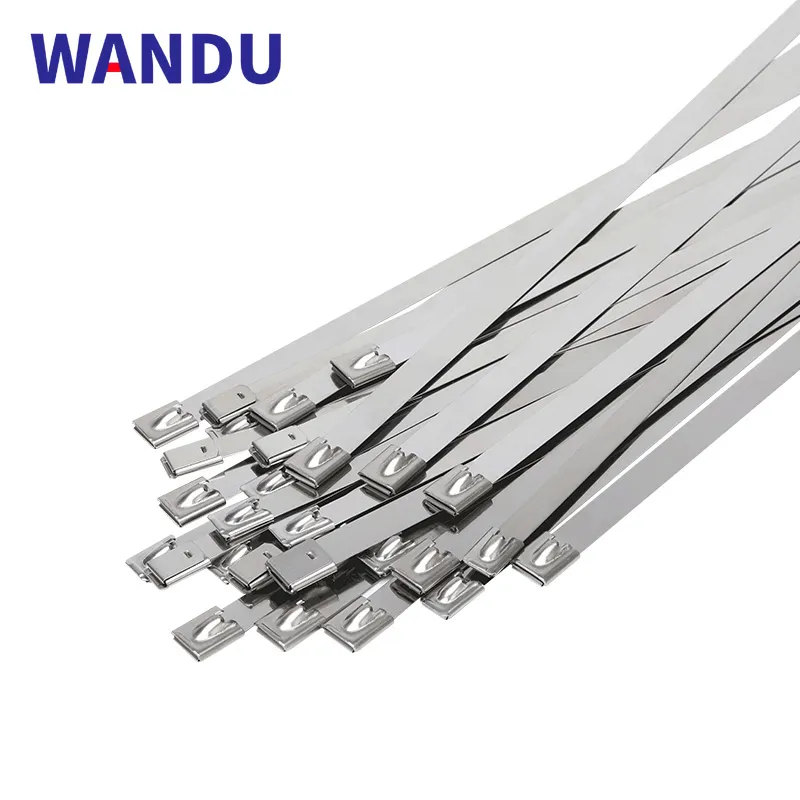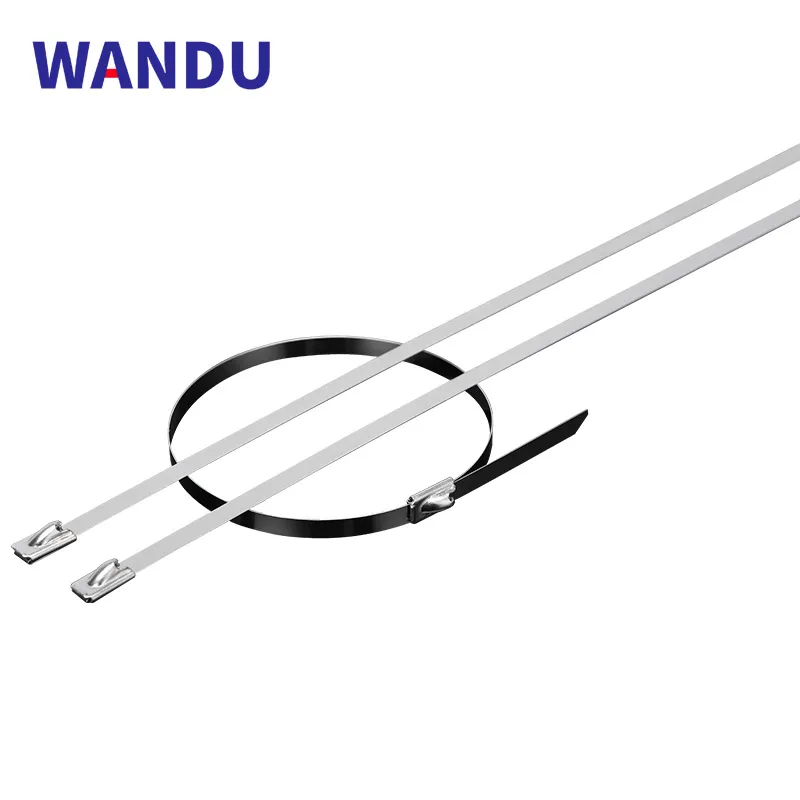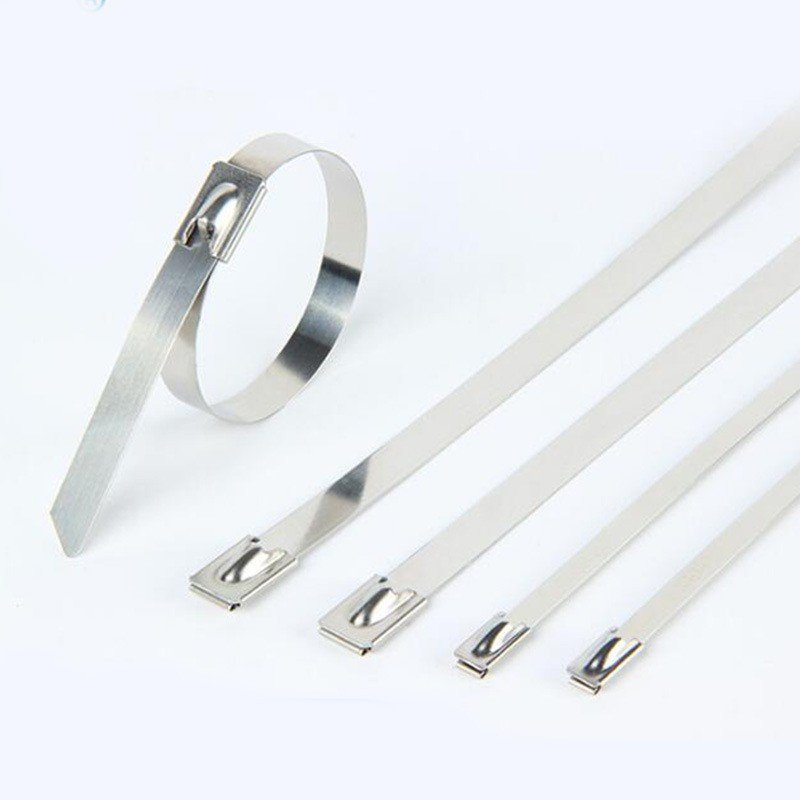1. What is Ball Lock Stainless Cable Ties?
Ball lock stainless cable ties are heavy-duty fastening devices made of high-strength stainless steel strips and a ball locking mechanism. The core lies in the precision steel ball and conical cavity structure inside the head: when the cable tie stainless is inserted, the ball rolls, and when pulled in the opposite direction, it wedges instantly, forming a firm mechanical one-way lock. This purely physical mechanism ensures extreme reliability under vibration and temperature variations, providing basic safety assurance for harsh industrial environments. Suitable for extreme environments, wire ties metal are the preferred choice in marine, oil, and metallurgical chemical scenarios.
2. Ball Lock Structure Principle and Advantages
Principle:
The core of the ball lock mechanism lies in its sophisticated mechanical interlock design. When stainless cable ties are inserted into the locking head, the smooth surface of the strap easily pushes the internal precision steel ball. Once the tie is subjected to reverse tension, the ball immediately wedges into the conical cavity inside the head under the combined effect of spring pressure and surface friction, thus achieving a solid one-way mechanical lock.
Advantages:
Excellent vibration resistance and reliability: Unlike traditional ties relying on plastic elasticity, the pure mechanical locking mechanism effectively resists long-term vibration and stress relaxation, preventing accidental loosening and ensuring durable fastening under dynamic loads.
Higher safety and maintenance convenience: Once installed, the lock becomes irreversible, preventing unauthorized removal. When maintaining the cable tie stainless, a special ejector tool must be used to push the steel ball from a specific direction to safely release the lock, providing additional security for critical facilities.
3. Material and Specifications
The common stainless cable ties materials mainly include 201, 304, and 316 grades. The 201 material has a lower cost but limited corrosion resistance, suitable for ordinary dry environments. The 304 grade provides standard corrosion resistance, ideal for most outdoor and general industrial applications. For marine or highly corrosive conditions, 316 stainless steel with molybdenum is strongly recommended, offering enhanced salt and alkali resistance for harsh environments.
For outdoor or extra protection needs, coated stainless steel cable ties can be selected. The coating acts as a physical barrier, further improving corrosion and wear resistance. Below is the WANDU standard ball lock cable tie stainless specification table for reference.
Specification Table
| ITEM NO | Length (Inch) | Length (mm) | Width (mm) | Thickness (mm) | Max.Bundle Dia.(mm) | Min tensile strength (lbs) | Min tensile strength (N) |
|---|---|---|---|---|---|---|---|
| WD-4.6x100SS | 3.9″ | 100 | 4.6 | 0.25 | 25 | 180 | 800 |
| WD-4.6x150SS | 5.9″ | 150 | 4.6 | 0.25 | 37 | 180 | 800 |
| WD-4.6x200SS | 7.9″ | 200 | 4.6 | 0.25 | 50 | 180 | 800 |
| WD-4.6x250SS | 9.9″ | 250 | 4.6 | 0.25 | 63 | 180 | 800 |
| WD-4.6x300SS | 11.8″ | 300 | 4.6 | 0.25 | 76 | 180 | 800 |
| WD-4.6x350SS | 13.8″ | 350 | 4.6 | 0.25 | 89 | 180 | 800 |
| WD-4.6x400SS | 15.8″ | 400 | 4.6 | 0.25 | 102 | 180 | 800 |
| WD-4.6x450SS | 17.7″ | 450 | 4.6 | 0.25 | 115 | 180 | 800 |
| WD-4.6x500SS | 19.7″ | 500 | 4.6 | 0.25 | 128 | 180 | 800 |
| WD-4.6x550SS | 21.7″ | 550 | 4.6 | 0.25 | 141 | 180 | 800 |
| WD-4.6x600SS | 23.6″ | 600 | 4.6 | 0.25 | 154 | 180 | 800 |
| WD-4.6x650SS | 25.6″ | 650 | 4.6 | 0.25 | 167 | 180 | 800 |
| WD-4.6x700SS | 27.6″ | 700 | 4.6 | 0.25 | 180 | 180 | 800 |
| WD-4.6x750SS | 29.6″ | 750 | 4.6 | 0.25 | 191 | 180 | 800 |
| WD-4.6x800SS | 31.5″ | 800 | 4.6 | 0.25 | 193 | 180 | 800 |
| WD-4.6x850SS | 33.5″ | 850 | 4.6 | 0.25 | 208 | 180 | 800 |
| WD-4.6x900SS | 35.5″ | 900 | 4.6 | 0.25 | 217 | 180 | 800 |
| WD-7.9x100SS | 3.9″ | 100 | 7.9 | 0.25 | 25 | 225 | 1000 |
| WD-7.9x150SS | 5.9″ | 150 | 7.9 | 0.25 | 37 | 225 | 1000 |
| WD-7.9x200SS | 7.9″ | 200 | 7.9 | 0.25 | 50 | 225 | 1000 |
| WD-7.9x250SS | 9.9″ | 250 | 7.9 | 0.25 | 63 | 225 | 1000 |
| WD-7.9x300SS | 11.8″ | 300 | 7.9 | 0.25 | 76 | 225 | 1000 |
| WD-7.9x350SS | 13.8″ | 350 | 7.9 | 0.25 | 89 | 225 | 1000 |
| WD-7.9x400SS | 15.8″ | 400 | 7.9 | 0.25 | 102 | 225 | 1000 |
| WD-7.9x450SS | 17.7″ | 450 | 7.9 | 0.25 | 115 | 225 | 1000 |
| WD-7.9x500SS | 19.7″ | 500 | 7.9 | 0.25 | 128 | 225 | 1000 |
| WD-7.9x550SS | 21.7″ | 550 | 7.9 | 0.25 | 141 | 225 | 1000 |
| WD-7.9x600SS | 23.6″ | 600 | 7.9 | 0.25 | 154 | 225 | 1000 |
| WD-7.9x650SS | 25.6″ | 650 | 7.9 | 0.25 | 167 | 225 | 1000 |
| WD-7.9x700SS | 27.6″ | 700 | 7.9 | 0.25 | 180 | 225 | 1000 |
| WD-7.9x750SS | 29.6″ | 750 | 7.9 | 0.25 | 191 | 225 | 1000 |
| WD-7.9x800SS | 31.5″ | 800 | 7.9 | 0.25 | 193 | 225 | 1000 |
| WD-7.9x850SS | 33.5″ | 850 | 7.9 | 0.25 | 208 | 225 | 1000 |
| WD-7.9x900SS | 35.5″ | 900 | 7.9 | 0.25 | 217 | 225 | 1000 |
| WD-7.9x950SS | 37.4″ | 950 | 7.9 | 0.25 | 231 | 225 | 1000 |
| WD-7.9x1000SS | 39.4″ | 1000 | 7.9 | 0.25 | 243 | 225 | 1000 |
| WD-12x150SS | 5.9″ | 150 | 12 | 0.25 | 37 | 270 | 1200 |
| WD-12x200SS | 7.9″ | 200 | 12 | 0.25 | 50 | 270 | 1200 |
| WD-12x250SS | 9.9″ | 250 | 12 | 0.25 | 63 | 270 | 1200 |
| WD-12x300SS | 11.8″ | 300 | 12 | 0.25 | 76 | 270 | 1200 |
| WD-12x350SS | 13.8″ | 350 | 12 | 0.25 | 89 | 270 | 1200 |
| WD-12x400SS | 15.8″ | 400 | 12 | 0.25 | 102 | 270 | 1200 |
| WD-12x450SS | 17.7″ | 450 | 12 | 0.25 | 115 | 270 | 1200 |
| WD-12x500SS | 19.7″ | 500 | 12 | 0.25 | 128 | 270 | 1200 |
| WD-12x550SS | 21.7″ | 550 | 12 | 0.25 | 141 | 270 | 1200 |
| WD-12x600SS | 23.6″ | 600 | 12 | 0.25 | 154 | 270 | 1200 |
| WD-12x650SS | 25.6″ | 650 | 12 | 0.25 | 167 | 270 | 1200 |
| WD-12x700SS | 27.6″ | 700 | 12 | 0.25 | 180 | 270 | 1200 |
| WD-12x750SS | 29.6″ | 750 | 12 | 0.25 | 191 | 270 | 1200 |
| WD-12x800SS | 31.5″ | 800 | 12 | 0.25 | 193 | 270 | 1200 |
| WD-12x850SS | 33.5″ | 850 | 12 | 0.25 | 208 | 270 | 1200 |
| WD-12x900SS | 35.5″ | 900 | 12 | 0.25 | 217 | 270 | 1200 |
| WD-12x950SS | 37.4″ | 950 | 12 | 0.25 | 231 | 270 | 1200 |
| WD-12x1000SS | 39.4″ | 1000 | 12 | 0.25 | 243 | 270 | 1200 |
| WD-12x1050SS | 41.4″ | 1050 | 12 | 0.25 | 255 | 270 | 1200 |
| WD-12x1100SS | 43.3″ | 1100 | 12 | 0.25 | 268 | 270 | 1200 |
4. Application Scenarios
- Marine/Shipbuilding: With excellent salt and alkali resistance, stainless cable ties perform outstandingly in ship pipelines and marine facilities, resisting moisture and salt spray corrosion to ensure long-term safety and lifespan.
- Petroleum/Chemical Industry: In highly corrosive petrochemical plants, stainless tie wraps are used to bundle pipelines and secure equipment components, reducing leakage risks caused by material aging and ensuring stable operation.
- Wind Power/Power Facilities: Stainless wire ties are widely used in wind turbines for cable fastening and structural reinforcement. Their high strength and fatigue resistance meet long-term outdoor durability requirements.
- Railway/Bridge: Stainless tie wire provides long service life and low maintenance for cable and conduit binding, maintaining stability under temperature and weather changes.
- Metallurgy/Casting: In high-temperature workshops, stainless cable ties fasten thermal pipelines and equipment cables without deformation or embrittlement, ensuring safe and stable operation.
5. Installation Steps and Precautions
Installation Process:
Wrap the stainless tie wraps smoothly around the object and insert into the ball lock head to form a loop, then use a tensioning tool to tighten evenly to the preset value, and finally cut off the excess tail neatly.
Tool Suggestions:
For efficient installation, it is recommended to use professional tools. Stainless steel zip ties gun integrates tightening and cutting, improving installation efficiency and tension consistency, while ss cable tie pliers are suitable for tight spaces, offering flexible control and clean cuts.
Precautions:
- Control tension force: Avoid overtightening, especially on plastic or fragile surfaces.
- Leave necessary allowance: Reserve slight elasticity to accommodate thermal expansion and vibration.
- Check the lock head: Ensure the locking mechanism is clean and functional before installation.
- Prevent abrasion: Avoid direct contact with sharp edges; use protective covers if necessary.
- Regular inspection: Recheck tension after 24 hours or first load, and inspect periodically during maintenance.
6. Comparison with Other Cable Tie Types
| Comparison Item | Stainless Cable Tie | Nylon Cable Zip Ties | PP Cable Ties |
|---|---|---|---|
| Material Strength | Very High | Medium | Low |
| Temperature Resistance | -80℃~500℃ | -40℃~85℃ | -10℃~80℃ |
| Corrosion Resistance | Excellent (304/316) | Weak | Moderate |
| Service Life | 10+ years | 2-3 years | 1-2 years |
| Insulation | None (optional coated type) | Good | Good |
| Typical Application | Petrochemical, Marine, Power, Transportation | Indoor wiring, light-duty cables | Chemical/Pharmaceutical corrosive environments |
| Cost | High | Medium | High |
7. FAQ
Q1: Can stainless tie wire be used in seawater or salt mist environments for long periods?
A1: 304 or 316 stainless wire ties have excellent corrosion resistance and can be used long-term in saline environments.
Q2: Which is better to choose, 304 or 316(L)?
A2: 316 offers stronger corrosion and oxidation resistance but comes at a higher cost. For general use, 304 is a more economical choice.
Q3: Do stainless tie wraps require special tools for installation?
A3: Yes, installation requires stainless steel zip ties tools, such as stainless cable tie pliers or ss cable tie gun.
Q4: How does it perform under high or low temperatures?
A4: Stainless cable ties have a temperature range of -80℃ to 500℃, making them ideal for extreme temperature conditions.






